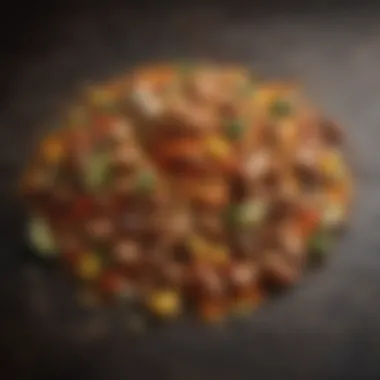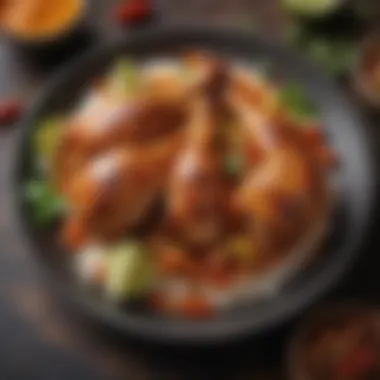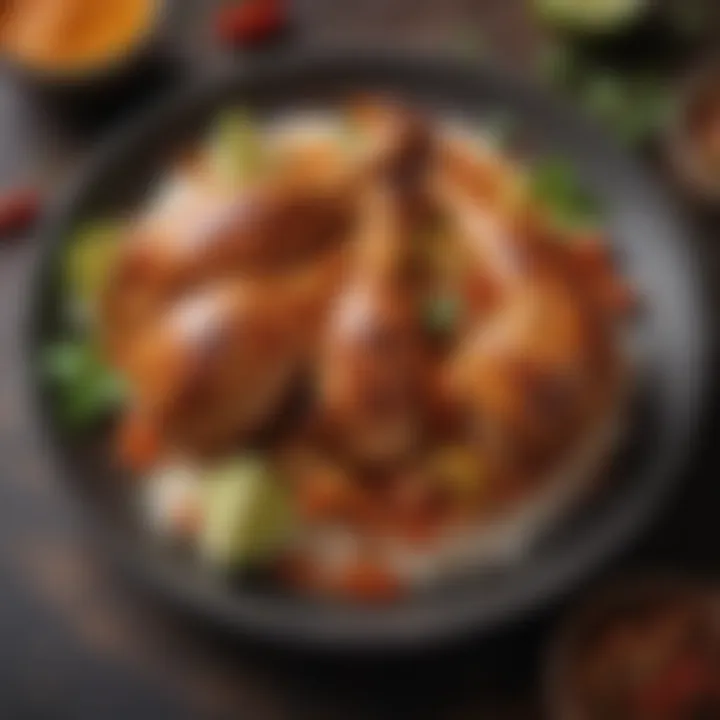Exploring the Spices of Peruvian Chicken Cuisine


Intro
Peruvian cuisine is a beautiful tapestry woven from diverse cultural influences, flavors, and techniques. Among its many stars, Peruvian chicken stands out, often prominently highlighted by its vibrant spices. Understanding these spices is not just about culinary techniques; it's a gateway into the heart of Peruvian culture itself. Through generations, cooks have perfected the art of balancing flavors and presenting dishes that resonate deeply with the land's rich history. In this journey, we will explore the essential spices that contribute to the distinct flavor of Peruvian chicken, delve into their origins, and offer insight into how home cooks and professional chefs can incorporate them into their kitchens.
Cooking is an art that is as much about knowing the ingredients as it is about technique. The beauty of Peruvian chicken lies in the complexity of the spices used. Here, we'll not only discuss the widely recognized ingredients but also look at some less common spices that can elevate a dish to sublime heights. Let’s roll up our sleeves and dive into the savory world of these spices, gleaning wisdom from culinary traditions that span vast geographical and historical contexts.
"Spices are to cuisine what paint is to a canvas – they bring flavor and vibrancy to the final artwork."
This exploration can help you hone specific skills. Understanding flavor profiles leads to better pairing and balance, while mastering spice blends opens up a world where your culinary creativity can truly shine. Whether you’re a novice hoping to impress at dinner parties or a seasoned chef looking for fresh inspiration, this culinary exploration into Peruvian chicken spices is sure to provide you with indispensable insights.
Prologue
In the world of culinary arts, few cuisines pop out quite like Peruvian. The unique .fusion of flavors rooted in Peru’s rich history offers a culinary experience that's simply unforgettable. Understanding the spices and techniques behind Peruvian chicken allows food enthusiasts of all skill levels to appreciate not just the tastes, but the cultural narratives they carry.
When one talks about Peruvian chicken, it's a veritable symphony of spices, each contributing a note that brings just the right depth and character to the dish. The importance of these spices can't be overstated since they define the very essence of its flavor profile, bridging the past and the present. How these spices are blended reflects centuries of influence from indigenous practices, colonial legacies, and global culinary trends.
The exploration of these spices unravels layers of complexity and shows that Peruvian cuisine is more than just food; it is a story poured into every ingredient. Each spice, like aji amarillo, has its own history and brings not only heat but also heart to the dishes.
In this article, we'll delve into the core spices that enhance Peruvian chicken, various spice blends, cooking methods, and even contemporary adaptations. Expect to discover the health benefits these spices provide, encouraging cooks everywhere to not just create meals but also embrace the culture that surrounds them.
"Cooking is about creativity; it's not just about following a recipe. It's about what tastes good to you, eating with heart and soul in every bite."
This understanding will not only boost one's cooking repertoire but also cultivate a deeper connection to the vibrant tapestry that defines Peruvian cuisine.
The Allure of Peruvian Cuisine
When one encounters Peruvian dishes, it’s hard not to be taken in by their aroma, vibrancy, and the sheer variety that dances across the palate. Peruvian cuisine is like a mosaic, carefully crafted from various historical influences that have shaped its development over centuries.
The land itself is bountiful, yielding an array of ingredients, from rustic potatoes found in the Andes to the spiciness of peppers cultivated along the coast. Each dish tells a story, rich with the culinary techniques developed by indigenous peoples and further enriched during the colonial period.
Many food lovers gravitate toward Peruvian cuisine because it celebrates diversity. For example, the incorporation of Asian flavors after the immigration of Chinese and Japanese workers has elevated traditional dishes to new heights. One can enjoy aji de gallina, a creamy chicken dish, or succulent pollo a la brasa, where marinated chicken is roasted to perfection. These are not mere meals; they are experiences that resonate with anyone who steps into the world of Peruvian cooking.
By understanding and appreciating Peruvian chicken spices, we uncover a deeper layer of cultural richness. So why not set foot away from the usual fare? Explore the spicy allure of Peru through its chicken dishes that burst with flavors and evoke a tapestry of stories, waiting just for you.
Historical Influences on Peruvian Flavors
Understanding the historical influences on Peruvian flavors is crucial for grasping the full picture of Peruvian chicken spices. This narrative reveals how diverse cultures converged over centuries, blending their unique culinary heritages to create the rich tapestry we appreciate today. As we explore this history, we uncover the specific elements that have enriched local cuisine, the benefits of their integration, and the significance of traditional practices that continue to shape Peruvian cooking today.
Indigenous Ingredients and Techniques
Before the arrival of any outsiders, the indigenous peoples of Peru had a well-established culinary foundation. They used a variety of local ingredients and traditional techniques that are still relevant in contemporary cooking. Maize, potatoes, and various native herbs were staples in their diets, deeply influencing the flavors familiar today.
These ancient communities were skilful with their techniques, utilizing fire-roasting and pit-cooking, developing charbroiled flavors and textures. An example is the preparation of pachamanca, a traditional dish that involves steaming food using hot stones in a pit, representing a unique cooking method passed down through generations. The spices may not have been as varied as they are now, but their knowledge of the land and its offerings allowed them to create flavors that still resonate in Peruvian cuisine.
Spanish Colonization and its Legacy
The arrival of the Spanish in the 16th century marked a seismic shift in Peruvian gastronomy. With them came new ingredients and cooking methods. They introduced garlic, cumin, and various meats, which not only enriched flavors but also transformed traditional ways of cooking.
The blend of these Spanish ingredients with local produce birthed a culinary fusion that exemplified the mestizo culture of Peru. While the Spanish brought their techniques, such as frying and Spanish-style stews, they also adapted to local flavors, incorporating aji varieties and the use of cilantro in their dishes. The legacy of this colonization lingers today, visible in dishes like aji de gallina, which showcases the combination of Spanish influences and indigenous roots.
Integration of Asian Flavors
Due to migration patterns, particularly in the 19th century, Asian flavors found their way into Peruvian kitchens. The arrival of Chinese and Japanese immigrants introduced a new range of ingredients and cooking styles, further diversifying the culinary landscape. This integration is evident in dishes like chifa, a Peruvian-style Chinese cuisine. Where this fusion becomes particularly interesting is in the use of soy sauce, which has now made its way into various Peruvian marinades and sauces.


Rocoto, a spicy pepper native to Peru, has also mingled with Asian spices, creating an interesting blend of heat and flavor. Understanding this aspect highlights how Peru's culinary narrative is continuously evolving, shaped by an ever-changing mix of influences.
"The history of Peruvian flavors is a captivating crossroads of indigenous practices enriched by colonial aspirations and international migrations, creating a unique culinary identity still thriving today."
In summary, the historical influences on Peruvian flavors exemplify the nation’s rich cultural heritage. By examining indigenous practices, Spanish enhancements, and the integration of Asian flavors, readers can appreciate the depth and complexity that define Peruvian chicken spices. As we move forward, it becomes clear that each ingredient tells a story, and understanding this history is integral for anyone looking to explore the flavors of Peru.
Core Spices in Peruvian Chicken Recipes
The heart and soul of Peruvian chicken dishes lie within the specific spices that create a symphony of flavors. Each spice contributes not only taste but also a layer of history tied to the diverse cultures that have shaped Peruvian cuisine. Understanding these core spices is essential for anyone wanting to master the art of preparing authentic Peruvian chicken. The blend of these spices can elevate a simple meal into an experience, one that tells a story of the land and its people.
Aji Amarillo: The Signature Spice
Aji Amarillo is often celebrated as Peru's quintessential chili pepper. Its vibrant yellow hue is just the beginning of its remarkable qualities. This spice has a noticeably fruity, slightly sweet flavor profile, which enhances the flavors of chicken without overwhelming the palate. When used in marinades or sauces, it can impart a deep, rich color that makes a dish visually appealing.
In traditional recipes, you'll find it mingling with garlic and cumin, striking a balance that is both fiery and aromatic. This smooth blend does more than just add heat; it brings a distinct Peruvian identity to the dish. Many chefs say that no dish can truly shine without aji amarillo, making it a go-to for those looking to achieve authenticity in their cooking.
"A meal without aji amarillo feels like a song without a melody; it just doesn't hit the right notes."
Cumin: An Earthy Essential
Cumin is another depth-giving spice that is an essential player in Peruvian kitchens. Its warm, earthy notes can create a savory undertone that enhances the overall flavor of chicken dishes. Its rich aroma invokes warmth and comfort, making it a staple in both traditional and contemporary recipes.
Cumin is often used in conjunction with aji amarillo and garlic, multiplying the complexity of the dish. Used in rubs or marinades, it can help tenderize the meat while bringing out its natural juices. The use of cumin is particularly prominent in Andean cuisines where traditional cooking techniques amplify its presence.
Garlic: A Flavor Booster
When it comes to enhancing flavors, garlic stands tall among spices. Whether it's fresh or roasted, garlic contributes a pungent richness that wraps around the chicken, making every bite irresistible. In Peruvian cuisine, garlic is not merely an additive; it's a fundamental ingredient that penetrates the protein, marrying with other spices for a deeper, fuller taste.
A common practice is to create a paste with garlic, aji amarillo, and cumin, which can be slathered onto the chicken before cooking. This results in an explosion of flavors that pays homage to Peru's culinary heritage.
Paprika: For a Touch of Sweetness
Paprika often finds its way into Peruvian chicken recipes, providing not just color but also a subtle sweetness. This spice, known for being less spicy compared to others, adds layers of flavor that can soften the heat from chilies. Paprika can also enhance the overall appearance of the dish, turning it into a visual feast.
In many regions of Peru, smoked paprika is favored, which imparts a touch of smokiness alongside its natural sweetness. This sweet heat amalgamates perfectly with the other spices, creating a harmonious blend that tantalizes the taste buds.
Through the careful selection and combination of these core spices, cooks can explore the rich heritage of Peruvian chicken, embracing flavors that transport diners straight to the heart of Peru.
Peruvian Spice Blends
The world of Peruvian cuisine comes alive not just through its core spices but equally through the intricate blends that encapsulate its rich flavors. Understanding these spice blends is like opening a book on the history and culture of a country. Each blend tells a story—how the ingredients emerged from various influences and how they interact to create unique flavors and textures. This section focuses on two of the most significant blends: Adobo and Rocoto Salsa. Exploring these concoctions reveals the essence they bring to Peruvian chicken, their versatility, and their connection to tradition and modern culinary practices.
Adobo: A Versatile Marinade
Adobo is not merely a marinade; it is an emblem of Peruvian cooking, a sacred secret passed among generations. At its core, Adobo combines a medley of spices like cumin, oregano, and aji amarillo. However, what sets this blend apart is its adaptability. It can marinate chicken, pork, or even vegetables and elevate them to new culinary heights.
In many households, making Adobo becomes a family affair. Everyone pitches in to prepare the ingredients, which speaks volumes about its cultural significance. Here’s what makes Adobo remarkable:
- Flavor Infusion: Marinating chicken with Adobo not only flavors the meat but helps keep it moist during cooking. The blend works its magic by penetrating the chicken, ensuring every bite carries a burst of rich flavor.
- Culinary Tradition: Many Peruvian chefs swear by a family recipe of Adobo, highlighting how personalized it can be. Some may add fresh herbs while others lean on spices that carry personal stories and memories.
- Community Dish: Adobo is often prepared for gatherings. The aroma wafting through the neighborhood announces a celebration, building a sense of community.
- Cooking Versatility: Whether you're grilling, roasting, or stewing the chicken, Adobo enhances the dish without overpowering the natural flavors of the meat.
Rocoto Salsa: A Spicy Condiment
Rocoto Salsa is a dynamic hot sauce made from the rocoto pepper, a variety native to Peru. Unlike its famous cousin, the jalapeño, the rocoto pepper brings a distinctive flair. This salsa has a zest that can excite a dish without being a tongue-scorcher.


What makes Rocoto Salsa compelling is its ability to complement the simpler flavors of roasted Peruivan chicken:
- Flavor Balance: The salsa does not just add heat; it enhances the depth of flavors already present in the chicken. The inherent sweetness of the rocoto balances out the savory notes, creating harmony.
- Cultural Experience: When you dip into a bowl of Rocoto Salsa, you are tasting the heartbeat of Peruvian culture—its celebration of spice. This isn’t just food; it's a dance between heat and flavor.
- Customizable: Many families prepare their Rocoto Salsa, experimenting with garlic, lime juice, or even adding tomatoes to mellow the spice, making each batch unique.
"To many Peruvians, the meal isn’t complete without a splash of Rocoto Salsa, giving every dish a signature kick that’s both spicy and memorable."
In this culinary landscape, understanding Peruvian spice blends like Adobo and Rocoto Salsa not only enhances the experience of cooking chicken but also invites home cooks to experiment and share their culinary stories. It reflects the essence of Peruvian cuisine—a fusion of flavors that brings people together, transcending borders and generations.
Cooking Techniques in Peruvian Chicken Preparation
When it comes to the culinary treasures of Peru, the techniques used in preparing chicken dishes play a vital role in heightening the flavors and experiences of this vibrant cuisine. While spices establish the flavor profile, it’s the method of cooking that determines how these flavors meld together, creating an unforgettable meal. The techniques range from marination to grilling or roasting, each contributing uniquely to the final dish.
Marination for Flavor Depth
Marinating chicken isn’t just a step; it’s a transformative process that unlocks the essence of the spices used. The right marinade can turn a simple chicken dish into a culinary delight. In Peruvian cuisine, marination typically involves a combination of ingredients such as aji amarillo, garlic, and citrus juices like lime. The acids in citrus help to tenderize the meat, while the spices infuse it with deep flavors.
- Prolonged Flavor Absorption: Allowing the chicken to marinate for several hours or even overnight enhances the absorption of spices and flavors, leading to a richer taste.
- Conveying Culture: The traditional Peruvian approach to marination often utilizes local ingredients, reflecting a heritage steeped in a rich blend of cultures. It’s more than just culinary—it's a fusion of history.
- Health Benefits: Marinades often include herbs with antioxidant properties, like cilantro and oregano, providing not just flavor but nutritional benefits, too.
"A well-marinated chicken can offer a symphony of tastes, far beyond what the spices alone could achieve."
Grilling vs. Roasting
When it comes to cooking chicken, especially in Peruvian cuisine, grilling and roasting are two prominent techniques, each with its own charm and effect on flavor.
- Grilling: This method imparts a smoky flavor to the chicken, courtesy of direct heat. With charcoal or wood fires commonly used in Peru, the result is not just about cooking the meat; it’s about enhancing taste through the grilling process. The high heat caramelizes the exterior of the chicken, giving it a delightful char that complements the marinade.* Grilled chicken often pairs beautifully with sides like quinoa or fresh salads, elevating the entire meal.
- Roasting: Conversely, roasting provides an entirely different experience. Chicken prepared in an oven benefits from an even cooking temperature, leading to a juicy interior. Roasting allows for the skin to become crisp while retaining moisture within the meat. Additionally, the use of roasting pans can also facilitate the addition of vegetables, creating an entire meal in one dish.
Both methods have their champions in Peruvian kitchens, with grilling often preferred for summer gatherings, while roasting may be more common for family dinners. Ultimately, choice of technique relies on personal preference and the desired outcome, showcasing the versatility of chicken as a canvas for flavor in Peruvian cooking.
By exploring these cooking techniques, avid food enthusiasts can deepen their understanding of how different methods enhance flavor, allowing them to recreate authentic Peruvian chicken dishes at home.
Regional Variations of Peruvian Chicken Dishes
In Peruvian cuisine, chicken dishes are a melting pot of regional flavors and techniques, each boasting its own unique character. The variations often reflect local ingredients, cultural influences, and cooking methods, making them a fascinating subject of exploration. Understanding these regional differences not only adds to one’s culinary repertoire but also opens the door to a fuller appreciation of Peru’s rich gastronomic landscape.
Lima: Coastal Influences
Lima, being the capital and a coastal city, showcases chicken dishes that rival the freshness and vibrancy of the bustling ocean nearby. Here, chicken often intertwines with the robust flavors of the sea. Limeños, the people of Lima, are famed for their love of citrus—think limes and lemons—which beautifully enhance the subtleties of chicken flavors. Many recipes incorporate ingredients like aji amarillo, cilantro, and a splash of Peruvian corn to create a bright, zesty profile that lifts the dish to new heights.
One popular dish is Pollo a la Brasa, which is marinated in a variety of spices and then slow-cooked over charcoal, resulting in a tender, smoky flavor. This dish reflects the culinary creativity of Lima’s urban environment, where influences from Spanish, Chinese, and Japanese cooks come together to create something distinctively Peruvian.
Instead of coating the chicken in a thick sauce, Lima's coastal approach favors light seasoning that lets the natural flavors shine. A squeeze of lime before serving is common, balancing the richness of the meat with a refreshing acidity.
"In Lima, chicken isn't just dinner; it's an expression of the city’s energy and spirit."
Andean Region: Rustic Flavors
Traveling to the Andean region, the landscape dramatically shifts, reflecting the rusticity of the environment. Chicken dishes here tend to highlight the region’s indigenous roots. Hearty ingredients thrive at high altitudes, making their way into flavorful stews and roasts. In this region, you'll find hearty spices like cumin and rosemary used generously, showcasing the land's offerings with a touch of herbal depth.
One standout dish is Pollo al Horno – roasted chicken that’s often accompanied by a medley of locally grown vegetables. The style of cooking here is more rustic, often emphasizing slow cooking methods that allow the chicken to absorb the earthiness of the root vegetables and herbs.
Moreover, many Andean communities utilize techniques like pachamanca, which involves burying the marinated chicken and vegetables in heated stones underground. This traditional method of cooking not only infuses a smoky flavor but also ties the meal back to ancient practices, embodying a cultural heritage that is rich and layered.
The flavors from this region offer a comforting, satisfying profile that reflects the vastness and beauty of the Andean mountains. In Andean chicken dishes, each bite is steeped in tradition, telling the story of a place where food is both sustenance and a means of connecting with the land.


These regional variations of Peruvian chicken dishes demonstrate not only the adaptability of chicken as an ingredient but also the profound influences of geography, culture, and tradition in shaping a nation’s culinary identity.
Contemporary Adaptations and Fusion
In today’s culinary landscape, the intertwining of traditional cuisines with modern influences has become an intriguing phenomenon. The realm of Peruvian chicken dishes isn't exempt from this transformative wave. Contemporary adaptations and fusion play a crucial role in expanding the reach of Peruvian flavors beyond their borders. These adaptations not only breathe new life into classic recipes but also make them accessible and appealing to a diverse audience. Using unique or unconventional ingredients can lead to creative culinary experiences that honor the original spirit of Peruvian chicken while encouraging experimentation.
Incorporating Non-Traditional Ingredients
Shifting gears from traditional to modern, the incorporation of non-traditional ingredients into Peruvian chicken can be a game changer. For example, integrating elements like quinoa or local cheese can give a twist to classic dishes. Infusing international spices such as za’atar or tandoori masala into marinades invites an exciting fusion of flavors that keeps things fresh and intriguing. Imagine a succulent Peruvian chicken seasoned with a blend of ají amarillo and a hint of curry powder—that's a dish that not only surprises the palate but also showcases the versatility of the spices.
This blending doesn�’t come without its challenges. Balancing bold flavors is paramount; one ingredient shouldn’t overshadow the delightful complexity inherent in the Peruvian spice profile. Hence, it's important to experiment, taste, and adapt rather than overwhelm. Ultimately, the best adaptations embrace both respect for tradition and an openness to innovation.
Global Influences on Peruvian Chicken
Peruvian cuisine reflects a vibrant tapestry of cultural influences, and the global pulse is beating stronger than ever. This prominence of global influences invites chefs and home cooks to broaden their horizons. For instance, the Japanese-Peruvian fusion known as Nikkei includes dishes where delicate miso flavors meld with the robust notes of traditional Peruvian spices.
Let's not overlook the role of social media and culinary trends in this fusion journey. Platforms like Reddit and Facebook have become meeting grounds for food enthusiasts sharing recipes, tips, and new ideas. Here, cooks share innovative takes on Pollo a la Brasa, combining it with unexpected side dishes from various worldwide cuisines, showcasing versatility.
This cross-cultural exchange enhances the mainstay of Peruvian chicken. It encourages a lively dialogue between tradition and modernity, giving birth to unique culinary expressions that reflect the evolving nature of food.
"Food is not only a source of sustenance; it’s a bridge connecting cultures, experiences, and creativity."
Through these adaptations and fusions, Peruvian chicken is not just a dish; it becomes a canvas for expression where flavors and inspirations collide. It's about bringing people together through shared experiences and leaving an indelible mark on their palates, allowing the rich heritage of Peruvian spices to continue thriving in contemporary cuisine.
Health Benefits of Peruvian Spices
Exploring the health benefits of Peruvian spices sheds light on their potential beyond just enriching flavors in dishes. These spices are not only key players in creating that distinctive taste profile associated with Peruvian chicken, but they also pack a punch when it comes to nutrition. Understanding their health benefits helps home cooks and chefs alike appreciate their role in both culinary tradition and personal well-being. Diving into the specifics, it becomes clear that harnessing the power of these spices can elevate dishes while contributing positively to health.
Antioxidant Properties
Peruvian spices are well-regarded for their rich antioxidant content. Antioxidants are compounds that help combat oxidative stress in the body, potentially reducing the risk of chronic conditions like heart disease and cancer. Spices such as aji amarillo, cumin, and garlic are prime examples well known for their high antioxidant levels.
- Aji Amarillo: This vibrant yellow pepper is often a star in Peruvian cuisine. Beyond the necessary heat it adds, it’s loaded with carotenoids and polyphenols. These components not only enhance flavor but also protect cells from damage.
- Cumin: Known for its earthy aroma, cumin also contributes to antioxidant effects. Research suggests that it can lower risks of inflammation-related diseases, making it a smart choice in healthy cooking.
- Garlic: Perhaps one of the best-loved spices worldwide, garlic is not just flavorful. Its powerful antioxidants can help fortify the immune system and even improve heart health.
Incorporating these spices into day-to-day meals can be a delicious way to fight free radicals and boost overall health. As a bonus, their vibrant colors may brighten up plates, presenting a feast for the eyes as much as for the palate.
Digestive Health
Another noteworthy benefit of Peruvian spices lies in their potential to enhance digestive health. When you consider how spices benefit digestion, it’s vital to think about their role not only in adding flavor but also in promoting gut health. Ingredients like garlic, cumin, and paprika fall into this category as well.
- Garlic: Already noted for its antioxidant traits, garlic is also known for its prebiotic properties. It feeds beneficial gut bacteria, crucial for a well-functioning digestive system. The compounds in garlic can ease bloating and promote smoother digestion, helping you feel more comfortable after meals.
- Cumin: This spice does wonders for digestion, too. Simmering cumin seeds in water to make tea can help relieve symptoms of indigestion. It’s a common remedy in various cultures, offering support for everything from gas to bloating.
- Paprika: Often used to sprinkle flavor on various dishes, paprika also acts as a gentle digestive aid. Its properties can help stimulate digestive enzymes, which is essential for proper nutrient absorption.
Ultimately, introducing these spices into your cooking doesn’t just uplift flavors—it supports a healthy gut, making enjoying Peruvian chicken a truly fulfilling experience.
Integrating Peruvian spices into everyday meals not only enhances flavor but also promotes better health, proving that good food can be good for you.
Culmination
Navigating the world of Peruvian chicken spices ultimately reveals the intricacies and depth of flavors that make this cuisine so unique. This conclusion ties together the threads of history, regional diversity, and health benefits that these spices embody, creating a tapestry that not only enriches traditions but also invites contemporary exploration.
In discussing essential spices such as aji amarillo, cumin, and garlic, we see how each brings its own character to dishes, elevating the humble chicken into something extraordinary. The interplay of these ingredients is not merely about taste—it serves as a gateway to cultural stories and practices adopted over centuries.
Adobo and rocoto salsa not only serve functional purposes but also tell tales of Peruvian heritage, highlighting how food can act as a mediator of identity and history.
"In every bite of Peruvian chicken, one can taste not just the spices, but the journey of its people."
As we wrap up this culinary exploration, the takeaway is clear: embracing these spices does more than enhance your kitchen repertoire; it fosters a reverence for the cultural richness embedded in every recipe. With the wave of globalization and the blending of culinary influences, understanding these spices gives home cooks and professional chefs alike an opportunity to experiment and innovate, while still honoring traditional roots.
Ultimately, engaging with the spices of Peru transforms the cooking experience, transforming meals into stories seasoned with passion and history. By delving deeper into the complexity of these flavors, we also engage with the broader context of what food represents—community, memory, and a shared appreciation for the art of cooking.







